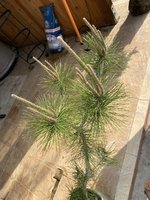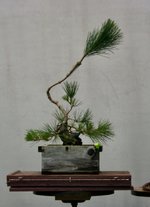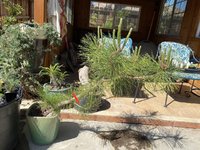I did mess up a bit according to your advice… I cut the central and strongest candles. It sounds like I should have cut the ones surrounding that if I’m hearing you correctly. Oh well, there are still several candles there so hopefully it does the trick!
No worries, when one wants a branch to extend keep the strongest remaining apical candle ( it will take over) and one other medium candle. remove the rest. This focuses the growth on extension for the sacrifice branch or leader. If you want to slow down the growth on a branch cut the apical candle off and shorten the other side candles. This is assuming that you are maintaining a reasonable number of candles and needles to maintain vigour. A general guideline is to reduce to two candles on all branches that are being maintained and treat the sacrifice branches or leaders as mentioned above.
The best guideline for developing JBP is to keep as many shoots, needles as possible for as long as possible. In other words remove only when they are creating a possible growth issue if left. Some of these are.
1. possibly shading a weaker area that is part of the design going forward.
2. creating inverse taper due to numerous branches remaining for too long on a whorl.
3. creating an imbalance in energy, JBP are apically dominant so the upper portion is watched carefully that it does not weaken the lower portion due to its excessive vigour.
Critical point that many misunderstand is that JBP can retain needles for four or five years if vigorous. This is an advantage to development because back budding occurs from " needle buds" and "adventitious buds" The longer you can keep needles the better the chance of a needle bud at the base of the needles. Adventitious buds are encouraged with wiring and opening up the area as one cuts back into the existing healthy needles.
For those advanced in developing pines the selective reduction of needles offers an opportunity to encourage shoots in specific locations rather than undesirable locations. Thus the direction could be to remove top and bottom needle pairs on a branch and leave side pairs where desired.
Bottom line: best not to make it a habit to
always remove last years needles when
developing young pines. This is an important step for further refinement and advanced development but can set back and slow down progress with younger trees in earlier stages of development. For several reasons. 1. less chance of needle buds 2. less vigour from lower level of photosynthesis with fewer needles. 3. makes for a more difficult stage of increasing shoot density in the interior later on in development.
Second critical point in development that is often misunderstood is the importance of new shoots lower down. Very few of the original shoots will be used in design, many more will occur in healthy stock after pruning back the sacrifice leader and branches during the various stages of development. The implications of this point are simply that with proper care and process many design opportunities will occur later in development. The focus on keeping initial shoots is important to contribute to health and vigour but not always the need for design.
If you think things through as follows it will help the most.
What stage is my tree at?
What steps are appropriate at this stage?
How healthy is my Tree? So how careful or aggressive can I be with the appropriate steps.
The above presupposes a clear understanding of the stages of development and therein lies the rub for those offering advice and those taking advice. Both need to be on the same page for advice to work. Ok off the soap box. Hope some of the above makes sense!










